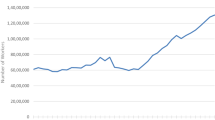Abstract
This paper evaluates the Swedish industrial policy for the textile and clothing industry and attempts to provide an interview-based method for assessing the effects of state intervention. The Swedish industrial policy, in the period 1970–1990, was general and defensive in character. In the majority of firms interviewed, government policy had either no effect at all on firm behaviour or where effects were found there were no underlying market imperfections. Only in a minority of firms was it found that the policy alleviated market imperfections and changed firms' investment behaviour in a way which was judged to be beneficial for the firms' competitiveness. Therefore, the Swedish industrial policy for the textile and clothing industry was associated with very substantial inefficiencies in the use of sizeable resources.
Similar content being viewed by others
References
Alange, Sverker, 1987,Acquisition of Capabilities through International Technology Transfer, Dept. of Industrial Management, Chalmers University of Technology, Göteborg.
Alänge, Sverker, Staffan Jacobsson and Sören Sjölander, 1991,Branschprogram Teko efter 1992 — utvärdering och förslag till alternativa industripolitiska insatser, Recomate AB for SIND, Stockholm.
Bäckström, Lars, 1990,Kartläggning av design och marknadsföringsföretag, November, Stockholm; SIND.
Carlsson, Bo, 1973,Importen från låglöneländer, Stockholm: IUI.
Carlsson, Bo and Gunnar Eliasson, 1991, ‘The Nature and Importance of Economic Competence’, paper presented to the EARIE conference in Ferrara, Italy, Sept. 1–3, 1991.
Consultus, 1990,Nyckeltal 1970–1989. Tekoindustrin i Sverige, 28.12, Stockholm: Consultus.
Consultus, 1992-04-07, Statistics on Textile Industry.
Corden, W. M., 1974,Trade Policy and Economic Welfare, Oxford: Oxford University Press.
Dahmén, Erik, 1950,Svensk Industriell Företagarverksammhet, IUI, Uppsala: Almqvist & Wiksell Boktryckeri AB. (an English version of this study was published by Irwin, Homewood, Ill. in 1970:Entrepreneurial Activity and the Development of Swedish Industry, 1919–1939).
Eliasson, Gunnar, 1990, ‘Commentary: Economics of Scale through Network Techniques and the Size of the State Space’,Booklet, no. 306, Stockholm: The Industrial Institute for Economic and Social Research.
Eliasson, Gunnar, Stefan Fölster, T. Lindberg, Thomas Pousette and Erol, Taymaz, 1990,The Knowledge Based Information Economy, Stockholm: The Industrial Institute for Economic and Social Research.
Huttin, Christine, 1989, ‘The Effects of State Aid on Employment and Investment in the French Textile and Clothing Industry’,International Journal of Industrial Organization 7(4), 489–501.
Jacobsson, Staffan, 1986,Electronics and Industrial Policy. The Case of Computer Controlled Lathes, London: Allen & Unwin.
Jones, Leroy P. and Il Sakong, 1980,Government Business, and Entrepreneurship in Economic Development: The Korean Case, Cambridge: Harvard University Press.
Kreuger, Anne, 1990, ‘Economists Changing Perceptions of Government’,Weltwirftschaftliches Archiv 126(3), 417–431.
Needham, D., 1978,The Economics of Industrial Structure and Performance, London: Holt, Rinehart and Winston.
Pack, Howard and Larry E. Westphal, 1986, ‘Industrial Strategy and Technological Change — Theory Versus Reality’,Journal of Development Economics 22(1), 87–128.
Porter, Michael, 1980,Competitive Strategy: Techniques for Analysing Industries and Competitors, New York: The Free Press.
SCB, 1992,Statistics from the National Swedish Bureau of Statistics, Stockholm.
Shishoo, Roshan, 1988, Förstudie beträffande nya material samt nya produktionsmetoder och — maskiner, Göteborg and Stockholm: The Swedish Institute for Textile Research (TEFO) and SIND.
Shishoo, Roshan, 1988a, Förstudie beträffande nya användningsområden för textilmaterial och textilprodukter, Göteborg and Stockholm: The Swedish Institute for Textile Research (TEFO) and SIND.
SIND, 1989,TEKO 89 — Bedömning av tekoindustrins utveckling 1989–90, SIND PM 1989: 2, Stockholm: Allmänna Förlaget.
SIND, 1990,TEKO 90 — Bedömning av tekoindustrins utveckling 1990–91, SIND PM 1990: 2, Stockholm: Allmänna Förlaget.
SIND, 1990a,Tekoindustrin under 90-talet, mimeo, Stockholm: The Swedish Industrial Development Board (SIND).
Westphal, Larry E., 1981, ‘Empirical Justification for Infant Industry Protection’,World Bank Staff Working Paper, No. 445, Washington, D.C.: World Bank.
Author information
Authors and Affiliations
Rights and permissions
About this article
Cite this article
Alänge, S., Jacobsson, S. Evaluation of industrial policy — The case of the Swedish textile and clothing industry. Small Bus Econ 6, 465–475 (1994). https://doi.org/10.1007/BF01064860
Received:
Issue Date:
DOI: https://doi.org/10.1007/BF01064860




